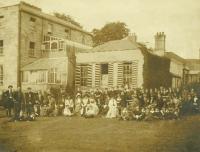St Enda’s School/Scoil Éanna by Joseph E.A. Connell Jr
Published in 20th-century / Contemporary History, General, Issue 3 (May/June 2011), Reviews, Volume 19
Parents and pupils at a St Enda’s open day at the Hermitage, Rathfarnham. Pearse is amongst the group of smaller boys sitting on the grass to the right. (Pearse Museum)
Founded by Patrick Pearse and Thomas MacDonagh, the first site of St Enda’s (Scoil Éanna) was Cullenswood House on Oakley Road, Ranelagh, Dublin. The school opened on 8 September 1908. It was originally conceived as St Lorcan’s School but took the name of St Enda of Aran, who abandoned the heroic life of a warrior to teach a devoted band of scholars in the remote seclusion of the Aran Islands. In 1910 the school moved to a site on Grange Road, Rathfarnham— an eighteenth-century house formerly known as the Hermitage, set on 50 acres of woods and parklands, enhanced by a lake and river near its boundary.St Enda’s influence on the Rising is clearly shown by the list of those who taught at or attended the school. In addition to Patrick and Willie Pearse and Thomas MacDonagh, Eamonn Ceannt and Con Colbert also taught there. Among the fifteen students who participated in the Rising were Desmond Ryan (he fought in the GPO and became a prolific author) and Joseph Sweeney (he was a sniper on the roof of the GPO; imprisoned at Frongoch, he was a TD for Donegal in the first three Dáils).Only the sciences, in which an Irish vocabulary was lacking, were taught in English, and the motto of the school was translated as ‘Truth on our lips, strength in our hands, and purity in our hearts’. The school was known for liberal teaching methods and unyielding nationalism. It was seen as a huge educational experiment at the time, with Pearse intent on providing a child-centred education to its pupils. Boys attending the school learned a range of subjects, from tending the large gardens to Egyptology, and they had their own informal magazine, An Scoláire (The Scholar). Enrolment went from 30 in 1908 to 130 in 1909–10, but shrank after that to 70 in 1910–11. After 1912 the numbers never reached 60, and in the final year before the Rising there were only 28 boys over fourteen who stayed for two terms. Among its teachers (full- or part-time) were William Carroll (physical education), Joseph Clarke, Padraic Colum, Dr Patrick Doody (classics), Tomás MacDomhnaill (music), Michael MacRuaidhri (gardening classes), Standish O’Grady and Michael Smithwick (mathematics). Guest lecturers included Alice Stopford Green, Edward Martyn, Dr Douglas Hyde, Eoin MacNeill, Mary Hayden, Sarah Purser and W.B. Yeats.After the Rising, the British occupied the school. Patrick and Willie’s mother, Margaret Pearse, reopened St Enda’s at Cullenswood House while the Hermitage was occupied. Then in 1919 she moved the school back to the Hermitage, and Thomas MacDonagh’s brother, Joseph, became headmaster. Ex-pupils Frank Burke and Brian Joyce returned as teachers after they were released from internment. Joseph MacDonagh was rearrested in 1917, and the ex-chemistry master, Peter Slattery, replaced him. Frank Burke was the last headmaster.Pearse was not a good businessman, and after a few years the school was always in financial trouble. Following its reopening, the financial problems increased and the school closed in 1935. Mrs Pearse bequeathed a life interest in the property to her daughter, Senator Margaret Pearse, and it passed to the Irish state upon Senator Pearse’s death in 1969. The Hermitage is now the Pearse Museum and its grounds form St Enda’s Park, both under the care of the Office of Public Works. Cullenswood House currently houses Gaelscoil Lios na nÓg, an Irish-language primary school founded in 1996. HI
Joseph E.A. Connell is the author of Dublin in rebellion: a directory 1913–1923 (Lilliput Press, 2006).
Further reading:
D.Ryan (ed.), The story of a success by P.H. Pearse, being a record of St Enda’s College, September 1908 to Easter 1916 (Dublin, 1917).D. Ryan, ‘St Enda’s—fifty years after’, in University Review (1958).T.J. White, review of Pearse’s patriots: St Enda’s and the cult of boyhood, in Celtic Studies Association Newsletter 22 (2) (2005).
















